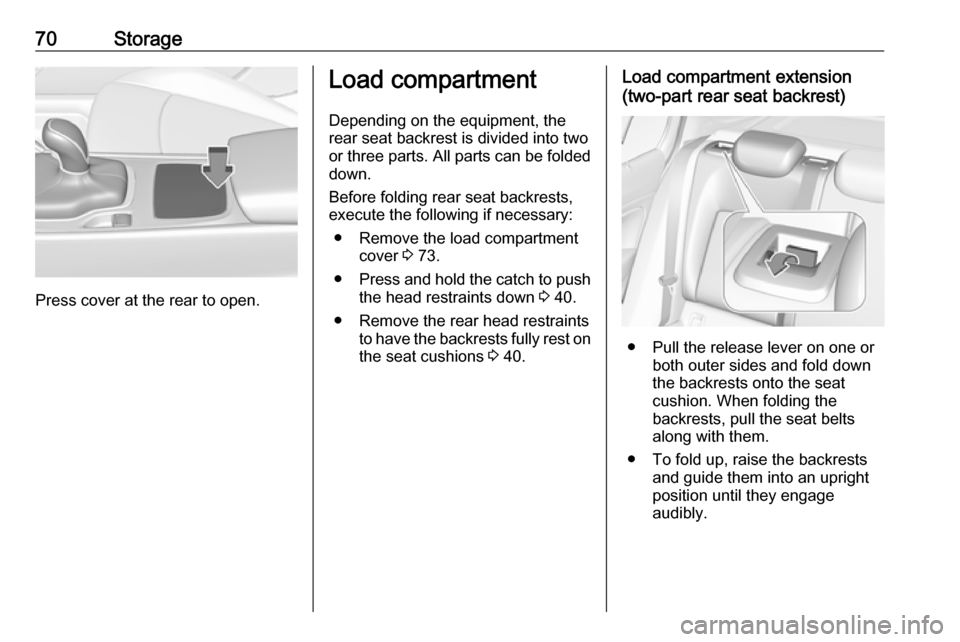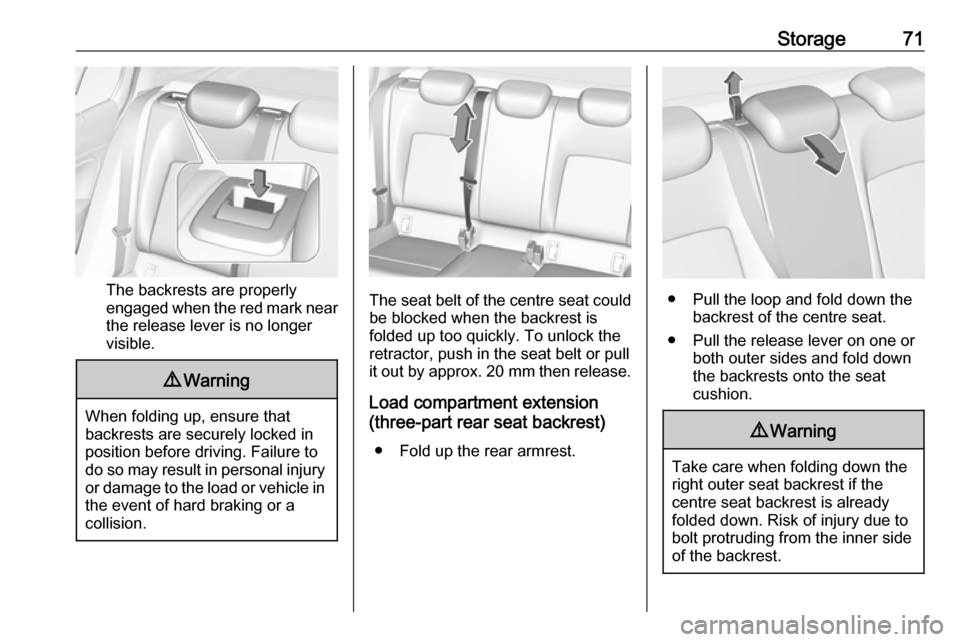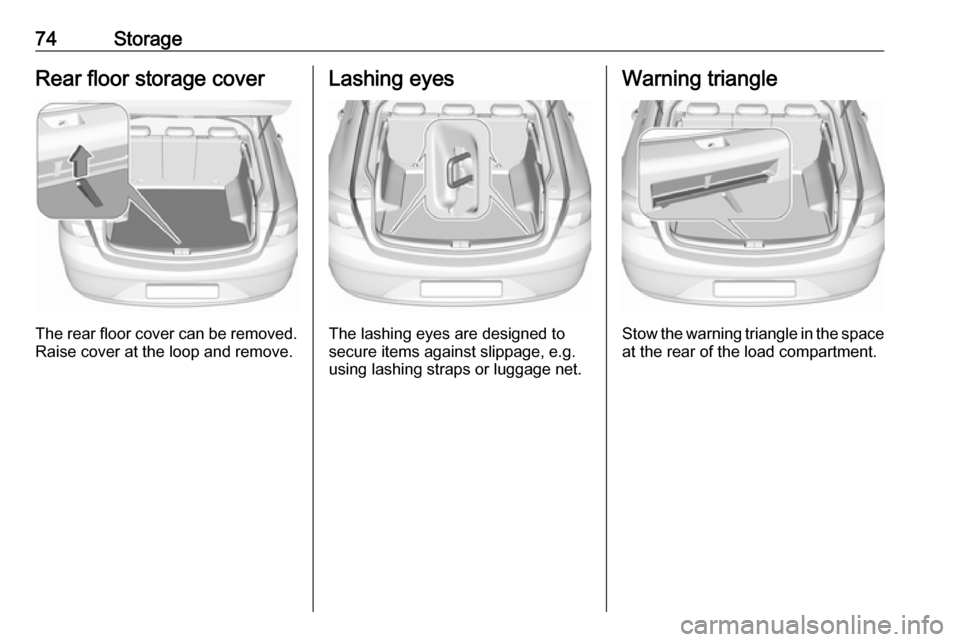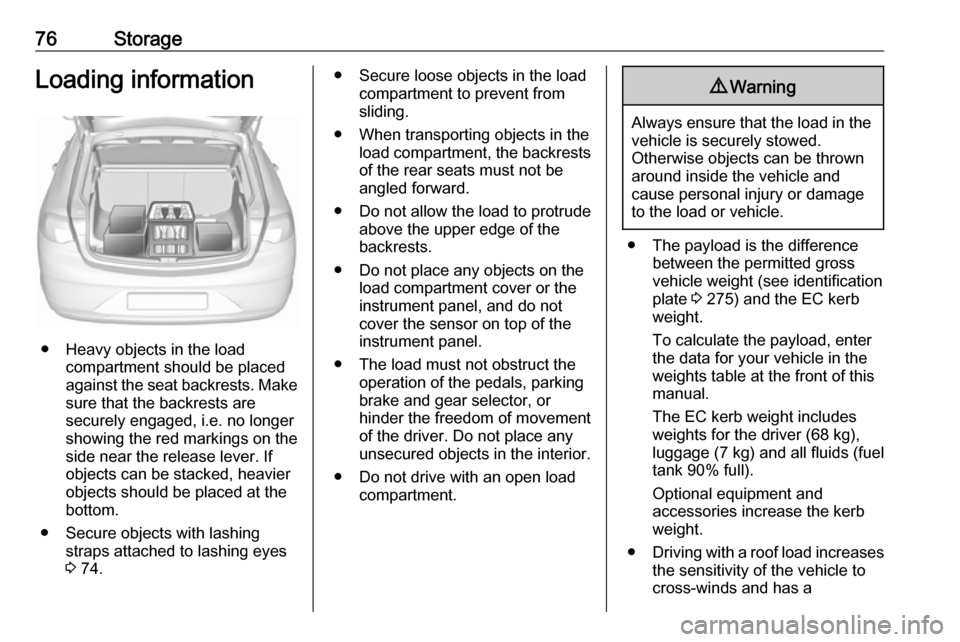OPEL INSIGNIA BREAK 2017.5 Manual user
Manufacturer: OPEL, Model Year: 2017.5, Model line: INSIGNIA BREAK, Model: OPEL INSIGNIA BREAK 2017.5Pages: 303, PDF Size: 8.46 MB
Page 71 of 303

Storage69
Additional cupholders are located in
the rear armrest. Fold down armrest.
Front storage
A storage box is located in the centre
console. Push cover to the front.
Sunglasses storage
Fold down and open.
Do not use for storing heavy objects.
Armrest storage
Storage in the front armrest
Push button to fold up the armrest.
Centre console storage The storage container can be used to
store small items.
Depending on the version, the
storage compartment is located
under a cover.
Page 72 of 303

70Storage
Press cover at the rear to open.
Load compartment
Depending on the equipment, the
rear seat backrest is divided into two or three parts. All parts can be folded
down.
Before folding rear seat backrests,
execute the following if necessary:
● Remove the load compartment cover 3 73.
● Press and hold the catch to push
the head restraints down 3 40.
● Remove the rear head restraints to have the backrests fully rest on
the seat cushions 3 40.Load compartment extension
(two-part rear seat backrest)
● Pull the release lever on one or both outer sides and fold down
the backrests onto the seat
cushion. When folding the
backrests, pull the seat belts along with them.
● To fold up, raise the backrests and guide them into an upright
position until they engage
audibly.
Page 73 of 303

Storage71
The backrests are properly
engaged when the red mark near the release lever is no longer
visible.
9 Warning
When folding up, ensure that
backrests are securely locked in
position before driving. Failure to
do so may result in personal injury or damage to the load or vehicle in the event of hard braking or a
collision.
The seat belt of the centre seat could
be blocked when the backrest is
folded up too quickly. To unlock the
retractor, push in the seat belt or pull
it out by approx. 20 mm then release.
Load compartment extension
(three-part rear seat backrest)
● Fold up the rear armrest.● Pull the loop and fold down the backrest of the centre seat.
● Pull the release lever on one or both outer sides and fold down
the backrests onto the seat
cushion.
9 Warning
Take care when folding down the
right outer seat backrest if the
centre seat backrest is already
folded down. Risk of injury due to
bolt protruding from the inner sideof the backrest.
Page 74 of 303

72Storage
● Pull the release lever on one orboth outer sides and fold down
the backrests onto the seat
cushion. When folding the
backrests, pull the seat belts along with them.
9 Warning
Take care when folding down the
right outer seat backrest if the
centre seat backrest is already
folded down. Risk of injury due to bolt protruding from the inner side
of the backrest.
● Alternatively fold seat backrests from the load compartment: pullswitch on left or right sidewall of
the load compartment to fold the
corresponding part of the rear
seat backrest.
9 Warning
Take care when operating the rear
backrests from the load
compartment. The backrest is
folded with considerable force.
Risk of injury, particularly to
children.
Ensure that nothing is attached to
the rear seats or located on the
seat cushion.
● To fold up, raise the backrests and guide them into an upright
position until they engage
audibly.
The backrests are properly
engaged when the red mark near the release lever is no longer
visible.
Page 75 of 303

Storage739Warning
When folding up, ensure that
backrests are securely locked in
position before driving. Failure to
do so may result in personal injury or damage to the load or vehicle in the event of hard braking or a
collision.
The seat belt of the centre seat could
be blocked when the backrest is
folded up too quickly. To unlock the
retractor, push in the seat belt or pull
it out by approx. 20 mm then release.
Load compartment cover
Do not place any objects on the cover.
Removing cover
Unhook retaining straps from tailgate.
Lift cover at the rear and at the front.
Remove the cover.
Fitting cover Engage cover in side guides and fold downwards. Attach the retaining
straps to the tailgate.
Page 76 of 303

74StorageRear floor storage cover
The rear floor cover can be removed.
Raise cover at the loop and remove.
Lashing eyes
The lashing eyes are designed to
secure items against slippage, e.g.
using lashing straps or luggage net.
Warning triangle
Stow the warning triangle in the space
at the rear of the load compartment.
Page 77 of 303

Storage75First aid kit
Stow the first aid kit on the right side
of the load compartment and secure it with the strap.
Roof rack system
Roof rack
For safety reasons and to avoid damage to the roof, the vehicle
approved roof rack system is
recommended. For further
information, contact your workshop.
Mounting roof rack
Open all doors.
Mounting points are located in each
door frame of the vehicle body.
Fasten the roof rack according to the installation instructions delivered with the roof rack.
Remove the roof rack when not inuse.
Page 78 of 303

76StorageLoading information
● Heavy objects in the loadcompartment should be placed
against the seat backrests. Make
sure that the backrests are
securely engaged, i.e. no longer
showing the red markings on the side near the release lever. If
objects can be stacked, heavier
objects should be placed at the
bottom.
● Secure objects with lashing straps attached to lashing eyes
3 74.
● Secure loose objects in the load
compartment to prevent from
sliding.
● When transporting objects in the load compartment, the backrestsof the rear seats must not be
angled forward.
● Do not allow the load to protrude above the upper edge of the
backrests.
● Do not place any objects on the load compartment cover or theinstrument panel, and do not
cover the sensor on top of the instrument panel.
● The load must not obstruct the operation of the pedals, parking
brake and gear selector, or
hinder the freedom of movement of the driver. Do not place any
unsecured objects in the interior.
● Do not drive with an open load compartment.9Warning
Always ensure that the load in the
vehicle is securely stowed.
Otherwise objects can be thrown
around inside the vehicle and
cause personal injury or damage
to the load or vehicle.
● The payload is the difference between the permitted grossvehicle weight (see identification
plate 3 275) and the EC kerb
weight.
To calculate the payload, enter the data for your vehicle in the
weights table at the front of this
manual.
The EC kerb weight includes
weights for the driver (68 kg),
luggage (7 kg) and all fluids (fuel
tank 90% full).
Optional equipment and
accessories increase the kerb
weight.
● Driving with a roof load increases
the sensitivity of the vehicle to
cross-winds and has a
Page 79 of 303

Storage77detrimental effect on vehicle
handling due to the vehicle's
higher centre of gravity.
Distribute the load evenly and
secure it properly with retaining
straps. Adjust the tyre pressure
and vehicle speed according to
the load conditions. Check and
retighten the straps frequently.
Do not drive faster than 120 km/ h.
The permissible roof load is
100 kg. The roof load is the
combined weight of the roof rack
and the load.
Page 80 of 303

78Instruments and controlsInstruments and
controlsControls ....................................... 79
Steering wheel adjustment ........79
Steering wheel controls .............79
Heated steering wheel ...............80
Horn ........................................... 80
Windscreen wiper/washer .........80
Rear window wiper/washer .......82
Outside temperature ..................83
Clock ......................................... 83
Power outlets ............................. 85
Inductive charging .....................86
Ashtrays .................................... 86
Warning lights, gauges and indi‐ cators ........................................... 88
Instrument cluster ......................88
Speedometer ............................. 93
Odometer .................................. 94
Trip odometer ............................ 94
Tachometer ............................... 95
Fuel gauge ................................ 95
Engine coolant temperature gauge ....................................... 96
Service display .......................... 96
Control indicators ......................97Turn signal................................. 97
Seat belt reminder .....................97
Airbag and belt tensioners .........98
Airbag deactivation ....................98
Charging system .......................99
Malfunction indicator light ..........99
Brake and clutch system ...........99
Electric parking brake ................99
Electric parking brake fault ........99
Antilock brake system (ABS) ...100
Gear shifting ............................ 100
Following distance ...................100
Lane keep assist .....................100
Electronic Stability Control off . 100
Electronic Stability Control and Traction Control system .........100
Traction Control system off .....101
Engine coolant temperature ....101
Preheating ............................... 101
AdBlue ..................................... 101
Tyre pressure monitoring system .................................... 101
Engine oil pressure ..................101
Low fuel ................................... 102
Immobiliser .............................. 102
Exterior light ............................ 102
High beam ............................... 102
High beam assist .....................102
LED headlights ........................ 102
Fog light ................................... 102Rear fog light........................... 103
Cruise control .......................... 103
Adaptive cruise control ............103
Vehicle detected ahead ...........103
Pedestrian detection ................103
Speed limiter ........................... 103
Traffic sign assistant ................103
Door open ................................ 103
Information displays ...................104
Driver Information Centre ........104
Info display .............................. 111
Head-up display ......................113
Vehicle messages ......................115
Warning chimes .......................116
Battery voltage ........................ 116
Vehicle personalisation ..............117
Telematics service .....................121
OnStar ..................................... 121